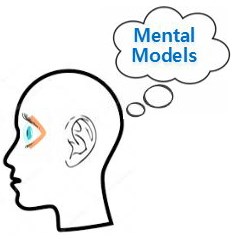
Mental Models
Mental models are a person’s conceptual representations of objects, places, theories, or situations.
These models are developed in the mind of the individual. They are mental images that the person has consciously or unconsciously formed from their experiences.
Everyone has unique models that differ in detail from other people’s model of the same concept. For example, when we say “tree,” someone living in Florida may have a mental image of a palm tree, while someone living in Vermont may have an image of a pine tree.
Complex Networks
Mental models are not just a mental pictures of singular objects like a television, tree, or dog. They are complex networks of information about how a person views a particular item, event, place, or concept in their mind. Individual mental models combine to form complex mental maps. Everyone has many complex models of common things and events in the world.
In a mental model, all of the parts are interconnected. For example, most people have a mental model of a kitchen. The model will probably link stove, refrigerator, table, cabinets, sink, dishes, and food. All these individual mental images are linked and interconnected to form the mental model for kitchen. Even though “food” is a part of the mental model for kitchen, it would also have its own model linked to other models including fruits, meats, vegetables, snacks, and bread.
People have thousands of mental models for places like schools, houses, or libraries. It is what they picture in their mind when they think of those places. They also have mental models for actions like playing games, buying items at a store, or attending a class at school.

Effects
As indicated earlier, mental models are a person’s conceptual representations of objects, places, theories, or situations, and these representations are so impactful they form a person’s beliefs, concepts, and stereotypes to ultimately create that person’s perception of reality.
These models are needed in daily life. They help explain cause and effect, set expectations, give meaning to events, and predispose people to behave in certain ways. They actually guide a person’s thoughts and actions, as well as play a significant role in decision-making and problem-solving.
Thinking
Mental models help people think by;
- helping organize information
- creating expectations
- creating points of reference
- making inferences
- linking information
- forming problem-solving models
Mental models help people comprehend new information because they organize background knowledge. When a person hears the term “kitchen”, they will probably think of stove, refrigerator, table, cabinets, sink, dishes, and food. By having a framework of knowledge, it is easier to learn new information.
On the contrary, people have a hard time learning new information about the topic when they do not have a mental model to structure their thinking. This explains why people with little background knowledge of a topic have a poor mental model for that topic, while a person familiar with the topic has an easier time comprehending any new information.
Additionally, these models guide people’s expectations. For example, if a person entered a kitchen and saw a bed in the middle of the floor, they would probably wonder what it was doing there. However, if they saw a table in the middle of the kitchen, they would not even think twice about it, since it was part of their mental model. Anything contrary to an existing mental model will slow down learning, while anything meeting that mental model will accelerate learning.
Unfortunately, models can interfere with learning because they are stereotypes. For example, if a person has only seen white refrigerators, they may create stereotype and assume all refrigerators are white. Stereotypes can set expectations, but they can also limit thinking.
Models Constantly Changing
Mental models will change as a person has more experiences and learns. Mental models shape how a person understands their experiences, and their experiences in turn shape their mental models.
If a person has only seen white refrigerators, they may think all refrigerators are white. If they encounter a black or stainless steel refrigerator, they may be a little confused at first, but they learn refrigerators can be other colors and their mental model for a “refrigerator” will change. This allows their mental models to become more diverse. Now if that person hears the term “refrigerator”, their mental model will now include white, black, and stainless steel.
Conclusion
Mental models are complex networks of information about how a person views certain objects, events, places, or concepts in their own mind. These models create that person’s perception of reality because it is how they see and understand the world around them.
These mental images are consciously and unconsciously formed all the time. They are constantly changing as a person experiences new situations and learns new things. The more they experience the more flexible and diverse their mental modes become.
Links
Knowledge, Skills and Attitudes
Knowledge, Skills, Attitudes and Habits
